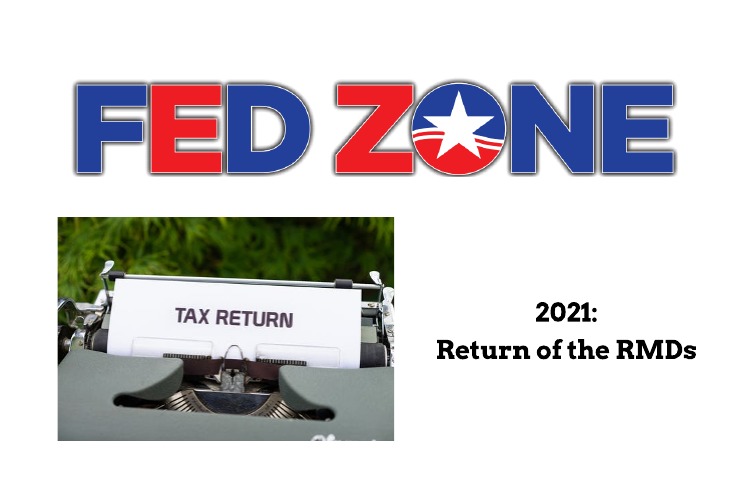This column explains how RMDs will be calculated during 2021 for those individuals who are required to take them. Before presenting the general RMD calculation procedure, it is useful to review what an RMD actually is.

Edward A. Zurndorfer
The year 2020 was one of the most eventful years in many ways. One way was with respect to the rules that govern retirement accounts and required minimum distributions (RMDs) associated with IRAs and retirement plans (including the TSP). The combined effect of the CARES Act that in fact waived 2020 RMDs, the delayed effective date of the new IRS life expectancy tables, and the increase of the starting RMD age from age 70.5 to age 72 (a result of the SECURE Act passage), will make it challenging for individuals and their financial advisors to keep track of the RMD rules over the next two years.
The first financial challenge associated with RMDs is the return of the RMD rules in 2021. Individuals who were required to take RMDs from retirement accounts during 2020 – including RMDs from qualified retirement plans, RMDs from Thrift Savings Plan (TSP) accounts (federal annuitants born before July 1, 1949), RMDs from traditional IRAs owned by individuals born before July 1, 1949 whether retired or not, and RMDs from beneficiary IRAs (traditional or Roth) owned by individuals of any age – were granted a waiver for taking their RMDs during 2020 as a result of the passage of the CARES Act. But anyone who is of RMD age in 2021 must resume their RMDs for 2021 and continue taking their RMDs for every year after.
This column explains how RMDs will be calculated during 2021 for those individuals who are required to take them. Before presenting the general RMD calculation procedure, it is useful to review what an RMD actually is.
An RMD is a minimum amount that an individual retirement account (IRA) owner or a retirement plan participant must withdraw from his or her retirement account in any RMD year. The retirement account owner or beneficiary can always withdraw more than the RMD if he or she wants to. The RMD is determined by taking the retirement account balance as of December 31st of the previous year and dividing it by a life expectancy factor. The life expectancy factor depends on the account owner’s or beneficiary’s age, either from the IRS’ Uniform Lifetime Table, or the IRS’ Joint (and Last Survivor) Life Expectancy Table. However, a distribution of less than the RMD amount will result in the account owner or beneficiary owing the IRS an excess accumulation penalty of 50 percent of the RMD shortfall.
Federal employees and annuitants who were age70.5 or older on December 31, 2019 (in other words, they were born before July 1, 1949) must take an RMD from their own (non-beneficiary) traditional IRA for 2021. Federal annuitants with TSP accounts who were age 70.5 or older as of Dec. 31, 2020 are required to take TSP RMDs during 2021. The TSP Service Office should be sending a letter in January 2021 to those annuitants explaining the resumption of TSP RMDs for 2021. The correspondence will also include an individual’s 2021 TSP RMD.
Federal employees or annuitants born after June 30, 1949 will not be subject to RMDs for 2021 when it comes to their traditional IRAs (both employees and annuitants) and TSP accounts (annuitants only). This is because these individuals would be under age 72 as of December 31, 2021. These individuals are required to take their first RMDs no later than April 1 following the year they become age 72.
RMDs for 2021 will be calculated using the existing life expectancy tables. In fact, RMDs for 2021 are calculated as if the 2020 RMD waiver had not occurred and that no “make-up” 2020 RMDs are required for 2021. It also means that in using the single life expectancy IRS table, non-spousal beneficiaries of IRA (both traditional and Roth IRAs) and qualified retirement plans (and the TSP) will calculate their 2021 life expectancy factor by subtracting two years from their 2019 life expectancy factor. The following information and examples will help explain.
Traditional IRA owners retired qualified retirement plan owners, and federal annuitants with TSP account born before July 1, 1949.
These individuals must take an RMD from their IRA or retirement account for 2021. The RMD will be calculated using the traditional IRA owner’s or qualified retirement plan/TSP participant’s account balance as of Dec. 31, 2020. They will also need the life expectancy factor from the IRS Uniform Lifetime Table. The 2021 life expectancy factor is obtained by subtracting two years from the 2019 life expectancy factor. For informational purposes, a portion of the IRS Uniform Lifetime Table is provided below:
IRS Uniform Lifetime Table*
| Age | Distribution Period | Age | Distribution Period |
| 70 | 27.4 | 86 | 14.1 |
| 71 | 26.5 | 87 | 13.4 |
| 72 | 25.6 | 88 | 12.7 |
| 73 | 24.7 | 89 | 12.0 |
| 74 | 23.8 | 90 | 11.4 |
| 75 | 22.9 | 91 | 10.8 |
| 76 | 22.0 | 92 | 10.2 |
| 77 | 21.2 | 93 | 9.6 |
| 78 | 20.3 | 94 | 9.1 |
| 79 | 19.5 | 95 | 8.6 |
| 80 | 18.7 | 96 | 8.1 |
| 81 | 17.9 | 97 | 7.6 |
| 82 | 17.1 | 98 | 7.1 |
| 83 | 16.3 | 99 | 6.7 |
| 84 | 15.5 | 100 | 6.3 |
| 85 | 14.8 |
Note that the Uniform Lifetime Table is used to compute lifetime RMDs for: (1) All unmarried traditional IRA owners, qualified retirement plan and TSP participants; and (2) married traditional IRA owners, qualified retirement plan and TSP participants, unless the spouse is (a) the sole beneficiary and (b) more than 10 years younger than the traditional IRA owner, qualified retirement plan or TSP participant.
The following is an example that illustrates:
Doris is age 73 and a federal annuitant with a TSP account. Doris is subject to RMDs from her TSP account. Her 2020 TSP RMD was waived by the CARES Act. In 2021 when Doris becomes age 74, she will be required to take a TSP RMD based on a life expectancy factor of 23.8 years. The 23.8-year life expectancy factor was obtained from the Uniform Lifetime Table above, for age 74.
Doris’ TSP account is worth $650,000 on December 31, 2020. Doris’ 2021 TSP RMD is computed as:
$650,000/23.8 = $27,311
Doris will not be required to make up the waived 2020 TSP RMD.
Traditional IRA and Roth IRA Beneficiaries
For those individuals who inherited traditional IRAs or Roth IRAs from other individuals, whether these IRA beneficiaries must take an RMD for 2021 depends on when (what year) the IRA was inherited.
- If an individual inherited the IRA before Jan. 1, 2020 (this includes both the traditional and Roth IRAs), the individual must take an RMD for 2021 if the beneficiary IRA must be distributed within five years (the “5-year” rule) and the IRA was inherited from an IRA owner who died during the year 2015. This is because 2020 was not counted due to the RMD waiver, making the year 2021 the fifth and final year of the five-year period. In particular, with respect to the five years: Year 1is 2016; Year 2 is 2017; Year 3 is 2018, Year 4 is 2019; and Year 5 is 2021. Under the five-year rule, distributions are optional until the end of the fifth year that follows the year the IRA owner died, at which time the entire account must be withdrawn. If the IRA beneficiary decided to take the IRA distributions under the life-expectancy rule, then the beneficiary must take an RMD for every year that follows the year in which the IRA owner died, except for 2020, and now during 2021.
- If an individual inherited an IRA (traditional or Roth), during 2020, the individual must make an RMD for 2021 if the individual is an “eligible designated beneficiary” (EDB). An EDB includes: (1) the surviving spouse of the IRA owner. However, the owner rules above apply if the surviving spouse elects to treat the IRA as his or her own instead of electing the beneficiary option; (2) a disabled individual; (3) a chronically ill individual; (4) a minor as defined under state law; or (5) none of above individuals but an individual not more than 10 years younger than the IRA owner.
Individuals who are not EDBs must withdraw their inherited IRA in its entirety by the end of the 10th year following the death of the IRA owner. This means that if the IRA owner died during 2020, the end of the 10th year would be Dec. 31, 2030. The IRA beneficiary who is not an EDB has the option of withdrawing the inherited IRA as he or she chooses provided the IRA is withdrawn completely no later than Dec. 31 of the 10th year following the death of the IRA owner. For example, the IRA beneficiary could withdraw the entire IRA during the 10th year. This means that any IRA withdrawals by non-EDBs for 2021 are optional.
You Might Also Enjoy This Podcast:
Edward A. Zurndorfer is a CERTIFIED FINANCIAL PLANNER™ professional, Chartered Life Underwriter, Chartered Financial Consultant, Chartered Federal Employee Benefits Consultant, Certified Employees Benefits Specialist and IRS Enrolled Agent in Silver Spring, MD. Tax planning, Federal employee benefits, retirement and insurance consulting services offered through EZ Accounting and Financial Services, and EZ Federal Benefits Seminars, located at 833 Bromley Street – Suite A, Silver Spring, MD 20902-3019 and telephone number 301-681-1652. Raymond James is not affiliated with and does not endorse the opinions or services of Edward A. Zurndorfer or EZ Accounting and Financial Services. The information has been obtained from sources considered to be reliable, but we do not guarantee that the foregoing material is accurate or complete. While we are familiar with the tax provisions of the issues presented herein, as Financial Advisors of RJFS, we are not qualified to render advice on tax or legal matters. You should discuss tax or legal matters with the appropriate professional.

